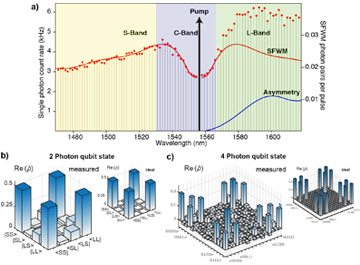 (a) Single-photon spectrum of the quantum frequency comb. (b and c) Real part of the measured (large) and ideal (small) density matrix for the (b) two- and (c) four-photon entangled states.
(a) Single-photon spectrum of the quantum frequency comb. (b and c) Real part of the measured (large) and ideal (small) density matrix for the (b) two- and (c) four-photon entangled states.
Nonclassical light sources of single and entangled photons are the backbone of future quantum communications infrastructure, and the cornerstone for realizing optical quantum computers. To reach practical applications, however, the enormous technical complexity of today’s sources must be drastically reduced through the development of integrated devices. The same tiny devices must also be capable of generating very large, complex entangled states. Only by satisfying these apparently contradictory requirements will it be possible to cut costs and, thus, move quantum technologies out of research laboratories and into our daily lives.
Recent years have seen significant progress in realizing compact sources of nonclassical light and functional waveguide circuits based on integrated photonics.1 Yet such sources have been limited to the emission of just two photons, and functional waveguide circuits have mainly relied on path-encoded schemes.2 The device footprint thus scales dramatically with the functional complexity, itself only achievable through an immense technological effort. This makes it difficult to exceed proof-of-principle operations.
In recent work, we have presented an approach for generating multiple two-photon and multiphoton entangled quantum states within a single waveguide mode.3,4 Using integrated optical frequency combs operating well below the optical parametric oscillation threshold, we generate photons on many frequency modes simultaneously through spontaneous four-wave mixing.3 Thanks to a judiciously tailored phase-matching condition, we have been able to generate photons over 100 frequency modes spanning the full S, C, and L telecommunications bands.4
Employing a double-pulse excitation scheme, we generated time-bin entangled photon states on all frequency modes,4 with the two- and four-photon entangled states confirmed by quantum state tomography.5 The measured and expected density matrices of the two- and four-photon states have shown very good agreement, with fidelities of 96 percent and 64 percent, comparable to those achieved in contemporary bulk setups.
We believe that these results represent an important milestone toward the scalable realization of complex quantum states on an integrated platform, and could open a new route for compact, cost-efficient quantum information processing.
Researchers
C. Reimer, M. Kues, P. Roztocki, F. Grazioso and T. Johnston, INRS-EMT, Varennes, Canada
R. Morandotti, INRS-EMT and IFFS, UESTC, Chengdu, China
B. Wetzel, INRS-EMT and University of Sussex, Brighton, U.K.
B.E. Little, Chinese Academy of Science, Xi’an, China
S.T. Chu, City University of Hong Kong, China
D.J. Moss, Swinburne University of Technology, Hawthorn, Australia
Y. Bromberg, Hebrew University of Jerusalem, Israel
L. Caspani, University of Strathclyde, Glasgow, U.K.
References
1. D. Bonneau et al., in Silicon Photonics III, Springer (2016).
2. J. Carolan et al. Science 349, 711 (2015).
3. L. Caspani et al. Nanophoton. 5, 351 (2016).
4. C. Reimer et al. Science 351, 1176 (2016).
5. D.F.V. James et al. Phys. Rev. A 64, 052312 (2001).
